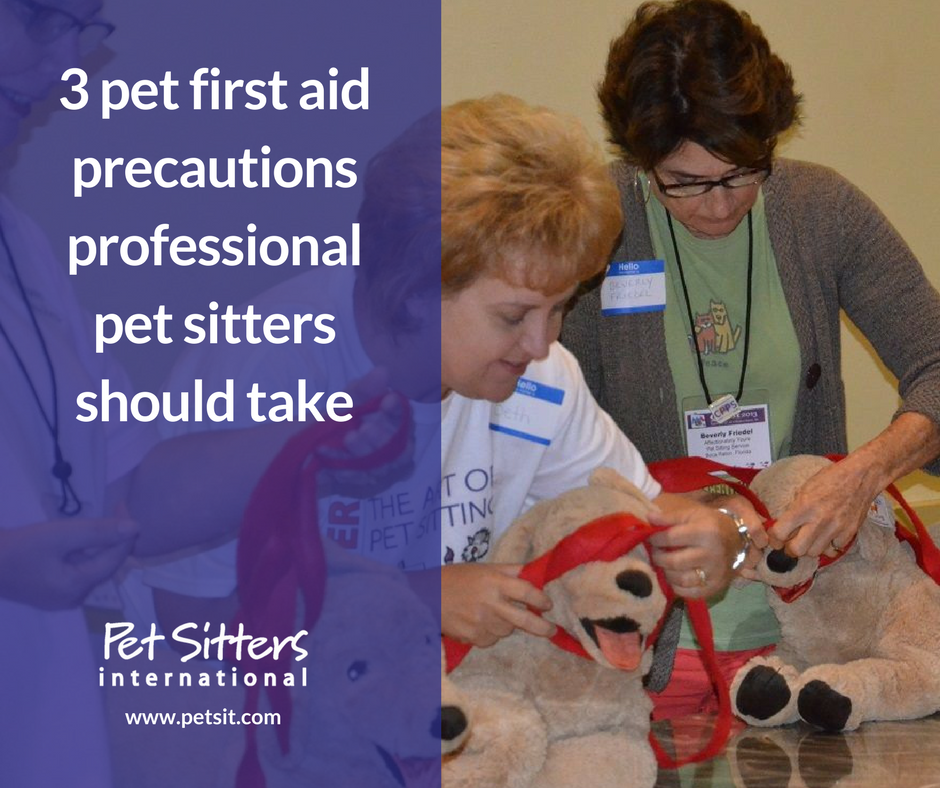3 pet first aid precautions professional pet sitters should take
Updated April 2025 | PSI Team

April is the American Red Cross’ Pet First Aid Awareness Month, and it offers a great reminder for professional pet sitters to brush up on their pet first aid know-how. What you do—or don’t do—in an emergency situation with a pet in your care could mean the difference between life and death.
According to the American Animal Hospital Association (AAHA), 25 percent more pets would survive if just one pet first aid technique were applied prior to getting emergency veterinary care.
PSI recommends that all professional pet sitters and dog walkers take these pet first aid precautions to ensure they are prepared to respond to pet emergencies:
1. Attend a pet first aid training class or program—more than once! Pet first aid knowledge and skills practice are essential for professional pet sitters. There are more options than ever before for both in-person and online pet first aid training programs. PSI offers an online course "Pet First Aid & CPCR for Pet-Care Professionals" with Pet Safety Crusader™ Denise Fleck, and she also offers a Pet First Aid & CPCR workshop at PSI’s annual Pet Sitter World Educational Conference & Expo.
A quick Google search for “pet first aid class + [your city/province]” will yield various results for companies offering trainings in the U.S., Canada and internationally—and multiple companies have recently started offering online programs. Be sure to consult with fellow pet sitters or other pet-care professionals for recommendations on pet first aid trainings and research the course content and format to find a training that best suits your learning style. Many pet sitters prefer in-person classes that allow hands-on training, but others may be comfortable with online trainings that offer video instruction.
Once you’ve been trained in pet first aid, it’s advisable to participate in the training or a refresher course again every two years. Also, continue to practice the skills you’ve learned throughout the year. Many skills—such as bandaging a pet—take practice, and you want to make sure that you are comfortable performing the task before you are in an emergency situation.
2. Ensure that you have a veterinary release/emergency pet-care authorization form on file for each client. While it’s important to have your clients’ up-to-date contact information on file, as well as contact information for their emergency contacts, there’s always a chance that you will not be able to reach someone in the event of an emergency. Having each client complete and sign a veterinary release/emergency pet-care authorization form indicates that you have the client’s permission to take their pet(s) to the veterinarian for emergency care. Many pet sitters also ask each client to indicate an amount (for cost of care) that the client pre-approves or others use forms that simply say the pet owner agrees to assume all costs of veterinary care. Some pet sitters also ask each client (or those who may be out of town for long durations of time or who may be in areas where cell service is unreliable) to have the veterinarian sign the form to indicate the veterinary office knows the pet(s) will be in the pet sitter’s care and the client has authorized the pet sitter to approve treatment. In some cases, clients have been able to leave their credit cards on file with veterinary offices or have an arrangement with veterinary offices to bill them upon their return. As a pet sitter, the information you require on your veterinary release form may depend upon your specific clients, your familiarity with the veterinarians your clients use and how long/how far away the clients may be.
Check with your veterinarian to confirm the appropriate authorization documentation needed. Learn more about roadblocks to use veterinary release and notification forms.
BONUS TIP: Also make sure you have the addresses for clients’ veterinarians and an emergency veterinarian option. Have these pre-programmed into your GPS if possible (or travel to veterinary offices in advance so you know how to get there) to avoid wasting valuable time searching for an address in the event of a pet emergency.
3. Always keep a pet first aid kit nearby. While “Always Prepared” may be a Scouts’ motto, it’s very important for professional pet sitters as well. Just like people, most pet accidents happen in or nearby the home. Examples of the most common pet accidents include toxic ingestion, dog bites, ripped toenails, foreign body ingestions with gastrointestinal problems, eye emergencies, broken bones, trouble giving birth and being hit by a car. One way to be prepared is to have a pet first aid kit on hand. Keep one in your vehicle at all times while on your pet-sitting rounds or overnight at a client’s home.
If your pet-sitting visits include taking pets on long walks or hikes, where you cannot quickly get back to your vehicle, also carry pet first aid supplies with you (in a backpack, for example). This PSI blog post shares a list of items you should include in your pet first aid kit.
In the event of a pet emergency, it is important to always call your veterinarian (or, if pet sitting, the client’s veterinarian), an emergency veterinary center or poison control immediately—and remember, above all, to stay calm. Many emergencies cannot be managed—even in the initial period—with simple pet first aid procedures so seek veterinary advice. In situations where you are able to administer first aid, it is still extremely important to seek veterinary care as soon as possible.
While all pet accidents and emergencies cannot be prevented, taking the three simple precautions above can help you be better prepared if you face a pet-emergency situation. Your clients and their pets are counting on you!
Pet sitters, are there other pet first aid tips you would recommend?
Share your feedback in the comments below.







Comments
Orven Gonzales
Denise Fleck